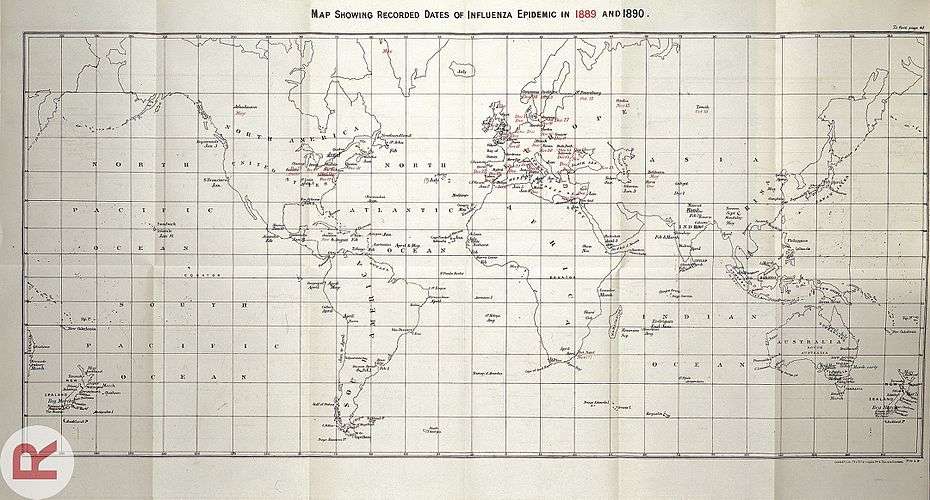1889–90 flu pandemic

The 1889–1890 flu pandemic (October 1889 – December 1890, with recurrences March – June 1891, November 1891 – June 1892, spring 1893 and winter 1893–1894) was a deadly influenza pandemic that killed about 1 million people worldwide. The outbreak was dubbed "Asiatic flu" or "Russian flu" (not to be confused with the 1977–1978 epidemic caused by Influenza A/USSR/90/77 H1N1, which was also called Russian flu). For some time the virus strain responsible was conjectured (but not proven) to be Influenza A virus subtype H2N2.[1][2] More recently, the strain was asserted to be Influenza A virus subtype H3N8.[3]
Outbreak and spread
The 1889 Russian flu was the first pandemic to occur in the modern connected world. The 19 largest European countries, including Russia, had 202,887 km of railroads and transatlantic travel by boat took less than six days (not significantly different than current travel time by air, given the time scale of the global spread of a pandemic).[3]
The pandemic was first recorded in Saint Petersburg, Russia in December 1889. In four months it had spread throughout the northern hemisphere. Deaths peaked in St Petersburg on December 1, 1889, and in the United States during the week of January 12, 1890. The median time between the first reported case and peak mortality was five weeks.[3]

Identification of virus subtype responsible
Researchers have tried for many years to identify the subtypes of Influenza A responsible for the 1889–1890, 1898–1900 and 1918 epidemics. Initially, this work was primarily based on "seroarcheology"—the detection of antibodies to influenza infection in the sera of elderly people—and it was thought that the 1889–1890 pandemic was caused by Influenza A subtype H2, the 1898–1900 epidemic by subtype H3, and the 1918 pandemic by subtype H1.[5] With the confirmation of H1N1 as the cause of the 1918 flu pandemic following identification of H1N1 antibodies in exhumed corpses,[6] reanalysis of seroarcheological data has indicated that Influenza A subtype H3 (possibly the H3N8 subtype), is the most likely cause for the 1889–1890 pandemic.[3][7]
Notable deaths
Initial pandemic
- 1 January 1890 Henry R. Pierson
- 15 January 1890 Walker Blaine
- 22 January 1890 Adam Forepaugh
- 22 February 1890 Bill Blair
- 12 March 1890 William Allen (VC 1879)
- 26 March 1890 African Spir
Recurrences
- 23 January 1891 Prince Baudouin of Belgium.[lower-alpha 1]
- 10 February 1891 Sofia Kovalevskaya
- 8 May 1891 Helena Blavatsky
- 15 May 1891 Edwin Long
- 3 June 1891 Oliver St John
- 9 June 1891 Henry Gawen Sutton
- 1 July 1891 Frederic Edward Manby
- 20 December 1891 Grisell Baillie
- 28 December 1891 William Arthur White
- January 1892 Charles A. Spring
- 10 January 1892 John George Knight
- 14 January 1892 Prince Albert Victor, Duke of Clarence and Avondale, grandson of Queen Victoria
- 20 January 1892 Douglas Hamilton
- 15 April 1892 Amelia Edwards
- 5 May 1892 Gustavus Cheyney Doane
- 24 May 1892 Charles Arthur Broadwater
- 10 June 1892 Charles Fenerty
- 21 April 1893 Edward Stanley, 15th Earl of Derby
- 31 August 1893 William Cusins
- 15 December 1893 Samuel Laycock
- 16 December 1893 Tom Cottingham Edwards-Moss
- 3 January 1894 Hungerford Crewe, 3rd Baron Crewe
- 24 January 1894 Constance Fenimore Woolson
- 14 March 1894 John T. Ford
- 19 June 1894 William Mycroft
See also
- Carlill v Carbolic Smoke Ball Company - Case in English contract law, concerning an advertisement of 1891 for a putative flu remedy
Footnotes
- ↑ Baudouin's death was officially attributed to influenza, although many rumors attributed it to other causes.
References
- ↑ Hilleman 2002, p. 3068.
- ↑ Madrigal 2010.
- 1 2 3 4 Valleron et al. 2010.
- ↑ Parsons 1891.
- ↑ Dowdle 1999, p. 820.
- ↑ Dowdle 1999, p. 821.
- ↑ Dowdle 1999, p. 825.
Sources
- Bäumler, Christian (1890), Ueber die Influenza von 1889 und 1890 (On the influenza of 1889 and 1890)
-
 Chisholm, Hugh, ed. (1911). "Influenza". Encyclopædia Britannica. 14 (11th ed.). Cambridge University Press. pp. 552–556.
Chisholm, Hugh, ed. (1911). "Influenza". Encyclopædia Britannica. 14 (11th ed.). Cambridge University Press. pp. 552–556. - Dowdle, W.R. (1999), "Influenza A virus recycling revisited", Bulletin of the World Health Organization, Geneva: WHO, 77 (10): 820–8, PMC 2557748
 , PMID 10593030
, PMID 10593030 - Hilleman, Maurice R. (August 19, 2002), "Realities and enigmas of human viral influenza: pathogenesis, epidemiology and control.", Vaccine, Elsevier, 20 (25–26): 3068–3087, doi:10.1016/S0264-410X(02)00254-2, PMID 12163258
- Madrigal, Alexis (April 26, 2010). "1889 Pandemic Didn't Need Planes to Circle Globe in 4 Months". Wired Science. Archived from the original on April 29, 2010.
- Parsons, H. Franklin (1891), Report on the Influenza Epidemic of 1889–90, Local Government Board, retrieved June 19, 2013
- Parsons, H. Franklin; Klein, Edward Emmanuel (1893), Further Report and Papers on Epidemic Influenza, 1889–92, Local Government Board, retrieved June 19, 2013
- Valleron, Alain-Jacques; Cori, Anne; Valtat, Sophie; Meurisse, Sofia; Carrat, Fabrice; Boëlle, Pierre-Yves (May 11, 2010). "Transmissibility and geographic spread of the 1889 influenza pandemic". PNAS. 107 (19): 8778–8781. doi:10.1073/pnas.1000886107. PMC 2889325
 . PMID 20421481. Retrieved January 14, 2013.
. PMID 20421481. Retrieved January 14, 2013. - Ziegler, Michelle (January 3, 2011). "Epidemiology of the Russian flu, 1889-1890". Contagions: Thoughts on Historic Infectious Disease. Archived from the original on 2013-06-22. Retrieved June 19, 2013.